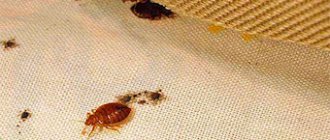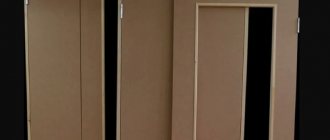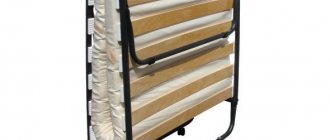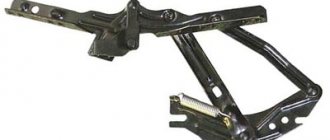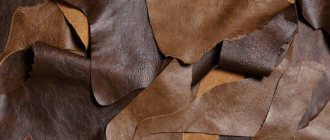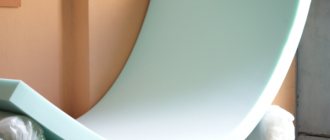When a person for the first time in his life encounters certain insects found in the sofa, it is very difficult for him to immediately determine who they are, what kind of unpleasant “guests” have settled in his upholstered furniture. It is for this reason that we want give you descriptions of several beetles and smaller insects that are more likely to live in sofas. There is no need to be afraid right away, even though the phenomenon is extremely unpleasant, but it is better to listen to some expert recommendations , which will help get rid of such “settlers” in the shortest possible time.
- Carpet beetle in upholstered furniture Difos
- Dezmol
- Cucaracha
- Karbofos
Determining who it could be
So, let's get to know the most active residents of sofa upholstery, inside a niche or between ottomans.
How to withdraw: effective methods
In recent years, the list of methods to combat these arthropods has expanded significantly. For example, effective insecticides have appeared that can kill insects in a short time. However, classic, proven methods should not be discounted either. In order for sofa bugs to disappear forever, you should treat your home according to all the rules.
How to properly treat a sofa
It is no coincidence that bed bugs are sometimes called couch bugs. It is in these upholstered furniture products that insects infest most often.
The process of removing bedbugs from a sofa has a number of features:
- insects feel comfortable in cramped spaces, so the ideal place for them to live is seams, folds, corners. Bedbugs can also settle on the back wall of furniture.
- The sofa must be processed from all sides, lifting, unfolding, moving it away from the wall.
- Particular attention should be paid to furniture drawers, if any. The bedding that is stored in them should be removed and subjected to heat treatment.
It is important to remember that bedbugs can nest not only inside the sofa.
Therefore, in order to permanently eliminate insects, you should also walk through other potentially dangerous places.
Mechanical method
This method is quite labor-intensive and ineffective. Before getting rid of furniture bugs, you should determine their nesting sites, walk through them with a bottle, manually collecting arthropods and their larvae. With this method of processing, there is a high probability of missing a couple of insects, which will begin to actively reproduce and quickly organize a new colony.
Vacuuming
This method is less labor-intensive, but more effective than the previous one. A huge plus for the squeamish – you won’t have to touch the sofa bugs with your hands. It is enough to go over all the seams and folds with a narrow nozzle. Before getting rid of bedbugs in the sofa, you should disassemble the furniture and move it away from the wall. The bag from the vacuum cleaner must be thrown away immediately so that insects cannot crawl around the room.
Temperature treatment
Treatment with hot water or steam is another effective method of getting rid of bedbugs. A temperature of 50 0C is already destructive for these insects. You can kill bedbugs using a steam cleaner. To do this, you should go over all the folds and creases. Covers for removable elements (sideboards, pillows) must be removed and washed. You can also pour boiling water over the seams and nesting areas, after making sure that such a procedure will not harm the furniture.
These insects cannot tolerate low temperatures either. In winter, you can put your furniture outside, and within a few hours the sofa bugs will die. After a week, the procedure must be repeated - during this period, new individuals will hatch from eggs that are resistant to cold. It is advisable that the temperature outside is below -150C.
Treating the sofa and other surfaces with an insecticide
This is one of the most effective and modern methods of combating these arthropods. Finding something to treat furniture against bedbugs will not be particularly difficult - stores selling household chemicals and gardening supplies offer a wide range of modern insecticides.
Processing is carried out according to the following scheme:
- buy insecticide. Since upholstered furniture will have to be treated, it is important that the chemicals do not leave traces on the upholstery. It would be good if the cylinder had a comfortable, long nozzle that would help penetrate even remote places.
- Clear the room of foreign objects, dishes, and food. It is important to ensure that items removed from the treatment area are free of parasites.
- Soft things that can serve as a place for bloodsuckers to live (toys, tablecloths, curtains, blankets, pillows, etc.) are taken away and washed at the highest possible temperatures.
- Pets, including reptiles and fish, are removed from the treatment area.
- Wear PPE (gloves, respirator, goggles, closed clothing).
- They take things to the center of the room and stick adhesive tape around the perimeter so that the insects cannot run away.
- The concentrated product is diluted according to the instructions. Treatment is carried out sequentially, starting with large clusters of sofa bugs. To enhance the effect, furniture can be wrapped in film and left for several hours.
- Carrying out general cleaning.
Despite the fact that sofas and other sleeping places are favorite places for parasites to settle, they can nest under wallpaper, behind baseboards, in sockets, and behind paintings. Therefore, all potentially dangerous places should be treated, and not just those where insects were found.
Effective drugs include the following: “Combat”, “Foresight”, “Executioner”, “Insecticide”, “Tetrix”, etc.
Professional Services
To treat premises, you can contact special services whose scope of activity includes disinfestation, deratization, and disinfection. In the arsenal of professional craftsmen there are powerful remedies that will help remove sofa parasites once and for all. The main disadvantage of such services is the price for their services, which may seem too high to clients. But specialists carry out comprehensive treatment of the room, often providing a guarantee that bedbugs will not reappear in the sofa.
Folk remedies
A homeowner who doesn’t know how to get bedbugs out of a sofa on his own will probably come up with the idea of using folk remedies. It is well known that couch bugs cannot tolerate the smell of tansy, so they try to stay away from this plant. You can also drive insects out of their homes using vinegar or a mixture of turpentine and laundry soap. True, the specific aroma will not only repel parasites, but will also create a certain discomfort for humans. In addition, the explosive mixture can leave stains on the upholstery of the sofa.
Tansy or wormwood flowers, placed under the bed or on the bed, can repel insects for a couple of days. When hungry, the bloodsuckers will overcome their hostility and go on the attack again.
Modern drugs
Nowadays there is a wide range of chemicals on sale that allow you to fight bedbugs.
Further in the table you can get acquainted with popular insecticides, their cost, effectiveness, toxicity level and choose the most suitable option.
| A drug | Release form | Efficiency | Toxicity level | Smell | price, rub. |
| Tetrix | Concentrate (diluted with water) | High | High | Strong, sharp | 2000 (250ml) |
| Get | Concentrate (diluted with water) | High | High | Absent | 800 (100ml) |
| Cucaracha | Concentrate | High | Average | Strong, sharp | 1500 (1l) |
| Fufanon (Karbofos) | Powder, concentrate | High | High | Strong, sharp | 150 (1l) |
| Forsyth | Concentrate | Average | Average | Strong, fades quickly | 250 (50ml) |
| Carbosol | Aerosol | Average | Average | The smell of coffee | 100 (300ml) |
| Pyrethrum | Powder | Low | Short | Weak | 600 (300g) |
| Riapan | Powder | Average | Average | Weak | 200 (125g) |
| Delta zone | Concentrate | Average | Average | Weak | 700 (50ml) |
| Combat | Aerosol | Average | Average | Mint flavor | 300 (300ml) |
| Raid | Aerosol | Average | Average | Strong, sharp | 200 (300ml) |
You should always remember that the more effective the product, the more toxic it is, and therefore poses a danger to human and animal health. The use of drugs must be carried out strictly according to the instructions in compliance with all safety measures.
If it is not possible to carry out the processing yourself, you can contact specialized services that will quickly carry out all the work and with the most positive results.
How to recognize the presence of parasites in the sofa
If residents have suspicions about the presence of parasites in the house, then the first thing that will interest them is how to find out if there are bedbugs in the sofa and furniture.
Indirect signs of the presence of insects:
- marks on the skin. The bites of sofa bugs left on the human body have one peculiarity - they follow a “path”, 3-4 at a time. This is due to the fact that the insect repeatedly pierces the skin on its way. Bites are accompanied by severe itching, redness, victims may experience an allergic reaction, and in severe cases, even iron deficiency anemia.
- Insect excrement and remains. Waste products (black specks that look like fine dirt) may appear under the sofa or on the bed linen. The victim may also stumble upon dead insects or empty shells left after molting.
- Stench. In the habitats of sofa bugs, you can smell a specific aroma, reminiscent of cheap cognac.
If at least one of these signs is detected, this is a reason to carefully inspect the sofa, lift the pillows, turn over the mattress, and look between the seams.
Do cockroaches bite at night?
Cockroaches rarely bite humans. They are inhabitants of kitchens, feeding on crumbs from the table and leftover food in trash cans. Only with very abundant reproduction and a lack of water can they crawl onto the bed and gnaw the epidermis around the lips and nose of people. Today, similar situations sometimes occur in hostels.
Of course, cockroaches are not blood-sucking insects, so even if they bite, it’s completely different from the way fleas or bed bugs do.
In any case, if you are bitten by insects, their bites should be treated to reduce itching and prevent infection:
- bite sites are washed with soapy water
- the most painful bites are wiped with alcohol or alcohol tincture of calendula or propolis
- Itching from bites can be reduced with Fenistil gel.
But if, after being bitten by blood-sucking insects, the temperature begins to rise and a characteristic rash appears on the skin, it is advisable to show the person to a doctor. An allergy to bites can have serious consequences, and even if at a particular moment it does not manifest itself very strongly, in the future the reaction to bites can be extremely acute.
The most modern, stylish apartment is not protected from insects. Small crawling, flying individuals do not pay attention to the degree of grooming or the design of the home. Penetrating in different ways, they can cause a lot of problems for the owner, especially if they choose a sofa as their habitat. In this article, we suggest finding out what can grow in upholstered furniture, and we will also tell you about the ways that insects can enter the apartment.
What do bedbugs look like?
Before starting full-scale treatment, you need to find out what a sofa bug looks like and make sure that these and not other parasites are infested in the furniture.
An adult reaches a length of 9 mm. It has a round, red-brown body that can swell if the parasite is full. There is a proboscis on the head, with which the sofa bug pierces the human skin.
Every day the female can lay 2-3 eggs, of which the larvae will hatch within a week. Insect larvae are white, almost transparent, they do not exceed 1–2 mm in length.
Fleas: when they bite and how to deal with them
A flea is a small jumping blood-sucking insect that attacks mainly during daylight hours. Not everyone thinks about it, but fleas can potentially carry plague, anthrax, typhoid, encephalitis, brucellosis and many other serious diseases, so you should be especially careful about protecting yourself from these parasites.
It was fleas and their hosts, rats, that became the cause of the extensive bubonic plague pandemic in the Middle Ages, during which almost a third of the European population died out.
Flea bites are quite similar to bedbug bites and can also form characteristic tracks, only short ones.
The photo shows a flea on human skin:
These insects are clearly visible on white bedding, but it can be quite difficult to catch them: they jump so quickly that the jump itself is not noticeable at all.
Fleas need to be removed in two stages: first, they are poisoned from pets, and then from the entire apartment.
Sometimes fleas have to be poisoned again if the infestation of the premises is especially high.
When baiting fleas in an apartment, the same drugs are used as against bedbugs. But to remove fleas from cats and dogs, you need to use completely different means, more gentle and safe, with reduced concentrations of insecticides.
Where do bedbugs come from?
Let's take a closer look at where bedbugs in the sofa come from and list the main ways insects penetrate inside the home.
Parasites can be introduced:
- when purchasing second-hand items;
- along with new furniture;
- when returning equipment from repair;
- with personal belongings of workers or guests entering the apartment;
- from the bathhouse and sauna.
Very often, sofa bugs crawl from neighbors through ventilation shafts, enter through cracks in door frames, and seep through cracks in walls.
Preventive measures
First, they protect the home from blood-sucking insects: they make cosmetic repairs, it is important to fill the gaps between the pipes leading into the apartment, restore the surfaces of the floor and walls in each room, and eliminate leaks in corner areas. Additionally, the ventilation ducts are covered with a fine-mesh insect net. Then the likelihood of bedbugs infesting your home is reduced.
The crumbling plaster is being restored in areas where sockets are installed - bedbugs often enter the facility through cable ducts.
To get rid of insects, purchased used items, including a sofa, are kept in the cold or washed at high temperatures. Use fresh herbs, such as wormwood.
Answers to popular questions
Let's look at the list of the most popular questions that people ask when encountering parasites for the first time:
- we bought a sofa, and after some time we discovered bedbugs inside it. Do these insects live in new furniture? Yes, sure. Often these parasites are brought into the house with new furniture. They end up there during storage in the warehouse or from the belongings of other customers.
- Do you need to throw away your sofa after treatment? If it is old and has been asking for a replacement for a long time, it is wiser to throw it away before processing and carefully inspect the room. If the furniture is new, there is no need to throw anything away; modern insecticides can destroy the entire population, including bedbug eggs.
- Can bedbugs get in a leather sofa? Yes, but such furniture is not suitable for these insects.
We'll take a closer look at the answers to the following popular questions.
Are bedbugs dangerous?
The sofa bug is dangerous because it can serve as a carrier of infectious diseases.
In addition, multiple bites (their number, if the room is heavily infested with parasites, can reach several hundred) disrupt restful sleep and can cause an allergic reaction. Victims (most often these are children) by scratching the bite site can introduce an infection into the wound, where an inflammatory process subsequently develops and an abscess breaks out. Sometimes, with regular blood loss, babies develop iron deficiency anemia.
Not everyone knows that marks on the human body are left not only by adult individuals, but also by their larvae. Unlike blood-sucking creatures that have reached sexual maturity, they are not able to inject an analgesic when piercing the skin, so their bites are quite painful.
Where is the largest concentration of insects in the sofa?
In upholstered furniture, sofa bugs are most often located:
- under the bottom.
- In places where the upholstery or structure is damaged (chips, holes, cracks, etc.).
- At the joints, between the armrest and the berth.
- Along the seams and folds of upholstery fabric, including the back wall of furniture.
To detect insects, you need to move the sofa away from the wall, turn it over, remove removable elements, raise the mattress and pillows.
How bedbugs infest sofas
Bed bugs do not appear immediately on the sofa. It happens that the insect was brought by someone from the street. Having detached itself from its host, the adult lives for some time in the folds of the sofa, periodically emerging for a meal. If the living conditions are suitable, she will begin to lay offspring; if not, she will crawl further in search of a more suitable home.
Insects that get inside the house along with furniture and household appliances, as a rule, already live there in entire colonies and actively breed. Then the process of forming a new settlement is a matter of time.
Why do bugs choose upholstered furniture?
We found out where insects can get into a home sofa, but why do they choose upholstered furniture? There are several reasons for this. Firstly, it is easier to hide in cracks and folds of upholstery and build a nest. Secondly, many pests prefer dry, untreated wood, which is easier to move on than on smooth surfaces. They also settle closer to food. Food, in different situations, is the person himself, or waste products: exfoliated cells, hair. Since rest mainly takes place on the sofa, there is the most dead epithelium on it.
Some types of insects, such as bedbugs, settle in the sofa in order to bite and drink human blood at night. Living in close proximity, they find the victim by smell and crawl out at night when the person is fast asleep and does not move.
Home remedies for pest control
To do this, you will need substances such as tar, naphthalene, and black carbolic acid. All this must be taken in equal proportions. If the bug has settled on not very valuable pieces of garden furniture, then it can be treated with hot drying oil. But this method is not suitable if the objects should not lose their original appearance. For such furniture, regular painting is suitable. This will remove unwanted guests from her. Also, items can be treated with flax oil and kerosene.
There is also a recipe: First, the surface should be treated with Vaseline oil. And the holes that remain after the pests have inhabited them need to be filled with the following composition: 3 parts turpentine, 1 part kerosene. Afterwards they need to be sealed with wax or paraffin.
Lice
Lice in your bed are rare. They spend their entire lives in the hairy part of the head. They are quite clumsy and slow, so any fall from their hair can be fatal for them. They constantly need blood, and once they fall down, it is no longer possible for them to climb to a food source.
As we have already said, they spend their entire lives on the head or pubic area of a person. There are also types of linen, but they are not so common now. They mainly affect homeless people and tramps who do not change or wash their clothes for a long time.
Lice bites are not as painful as those of fleas or bedbugs. But they can also cause a lot of discomfort with their itching.
These parasitic insects are removed with lice shampoos and sprays. At the same time, it is important to constantly comb them with a special fine-toothed comb.
Review
My daughter has very long thick hair. When she went to second grade, she accidentally caught lice from someone. When I remember how many times I took these parasites out of my head, it becomes scary. I probably bought different products five times, but in the end the lice shampoo helped. But I still had to part with my long hair. It's a pity, but what will you do? After that, apparently out of habit, I check her head almost every evening.
Elena, Arzamas
What types of grinders are there?
Today science knows a huge number of these insects that live in nature. The “domestic” beetle species includes several varieties. These are:
Furniture beetles include insects that have a body 2-5 mm long. In suitable conditions, it can breed several generations of young individuals within one calendar year. Its dark brown color will help you understand that it is he. In addition, it has stripes consisting of dots located on the elytra. In insect larvae can reach a size of 6 mm. They appear from eggs laid by the female insect. Often the female lays eggs in the most inaccessible places in wooden furniture. In this case, holes appear on the surface, the diameter of which is several millimeters.
Pests and vectors of infections
These types of insects can cause harm to property and human health:
Cockroaches
Very nimble insects of the cockroach order. They lead a nocturnal, secretive lifestyle. Body sizes range from 1.7 to 9.5 centimeters. They feed on plant and animal remains, various garbage and even feces. The color is mainly yellow-brown and black. Life expectancy is about 30 weeks, and in some species even several months. Habitat: basements, garbage cans, human dwellings. They harm indoor plants, book bindings, spoil food and furniture.
House ants
Tiny insects of the Hymenoptera family. They lead an active lifestyle next to a person. Body dimensions 2-4 millimeters. House ants are omnivores, but prefer meat, fish, and sweets. The color is mainly yellow and brown. They live in large families, the number of individuals reaching up to 1 million in one family. Life expectancy is as follows: males live only 20 days; working ants and ordinary females - up to 2 months; female queen – 275 days. They live mainly in human housing, trade and catering establishments. They harm plants, spoil food, and are carriers of all kinds of microbes.
Double-tailed
Insect type - arthropods, order - cryptomaxillary hexapods. They lead a secretive nocturnal lifestyle. They have a body 2-3 centimeters long. They feed on microscopic insects and living microorganisms. The color is red-brown. They live for about 1 year in damp rooms (bathroom, kitchen, etc.) They cause hostility in humans by their mere appearance, bite painfully, and damage plants, books, and furniture.
woodlouse
Arthropod insect order - isopods, suborder - crustaceans. They lead a hidden lifestyle (hiding under stones, lying trees) in damp places. The body length reaches 20 millimeters. Life expectancy is from 9 to 12 months. They feed on living and decaying plants. The color is gray, the abdomen is white. They do not cause harm to humans and do not pose a danger.
Carpet beetle
Beetle, order - Coleoptera, family of leather beetles. Lives mainly in houses, apartments, in nature in bird nests and tree hollows. Body dimensions range from 2.5 to 5.5 millimeters. It feeds on organic residues in house dust. The color is uniform from light brown to black. It is a serious pest of leather, fur, wool, feathers, silk, carpets and rugs, upholstered furniture and toys, as well as all types of grain and food.
Book louse
A small parasite, an insect of the order Hayeater. Lives everywhere: in the forest on trees, in bird nests, in rodent burrows, in human homes - mainly on shelves behind books. It has very small body sizes of 1-2 millimeters. Life expectancy is 3-4 weeks. The color is light brown, yellowish, whitish depending on the habitat. In nature it feeds on mushrooms and lichens, in the house on book bindings (remnants of paste or starch) and old albums, in barns on grain and other products. They cause irreparable damage to libraries and granaries.
Centipedes
Arthropod insects with body sizes from 2 millimeters to 35 centimeters. The body is divided into a head and a trunk, which consists of 25-100 segments and has a number of legs from 10 to 750. It is nocturnal and a predator. The color is most often gray, brown, less often reddish. Life expectancy reaches 5-6 years.
Fur moth
Insect, order Lepidoptera, butterfly. Body dimensions 5-8 millimeters. Leads a nocturnal lifestyle. The color is golden brown. Life expectancy is from 200 to 250 days. Lives in pigeon nests and living quarters. Representative of dangerous pests: destroys fur, wool, felt and products made from them.
Clothes moth
Lepidopteran insects in the form of a butterfly of straw-yellow color. Body sizes vary from 5 to 9 millimeters. They are nocturnal. They live on average 8-10 days, in residential buildings and warehouses. They feed on cotton, wool, fur, carpets, and furniture upholstery, thereby harming people.
Moshkara (midge)
Very small, very annoying insects of the Diptera family. Body dimensions 1-3 millimeters. The color is light brown. They lead a parasitic lifestyle. They love dampness. They are found in spoiled fruits and vegetables and food products. They feed on the blood of people and animals. Life expectancy is about 1 month.
Harvester spiders
Small insects, spider family. Body sizes can range from 2 to 10 millimeters, but they have very long legs up to 9 centimeters. The color is grey-brown. They are nocturnal. They like to live in dark, damp rooms, but in residential buildings they prefer dry, warm places near windows. They feed on flies and small insects, thereby benefiting people. Life expectancy 1 year. They have poison, but use it exclusively for the purpose of killing their victims caught in the web and only then eat them.
Terribly annoying insects, order Diptera. Body sizes, according to varieties, range from 5 millimeters to 1.5 centimeters. The color is gray-black. They lead a parasitic lifestyle. They live everywhere. They feed on everything that people eat, plant sap, human and animal excrement. Life expectancy is 1-2.5 months.
Silverfish
A small wingless insect, order - bristletail. Body dimensions 0.8-1.9 centimeters. They have a very beautiful silver color. They are nocturnal. They live in rooms with high humidity (most often in bathrooms, baths, saunas, etc.) They feed on everything that comes their way. They do not cause any particular harm and do not pose a danger to humans.
Reappearance after treatment
Preventing future bed bug infestations in your bed, what are the causes of bed bugs?
- Do not bring abandoned bed frames, mattresses, box springs or upholstered furniture into your home.
- Carefully inspect used or rented furniture before bringing it into your home.
- When traveling, inspect the bed, headboard and furniture upon arrival. Keep suitcases high off the floor and bed and inspect them before leaving. After returning home, thoroughly wash and dry all clothing.
- Seal and tape any cracks and crevices throughout the house, especially in areas where people sleep.
- Be careful with guests staying overnight in your home.
